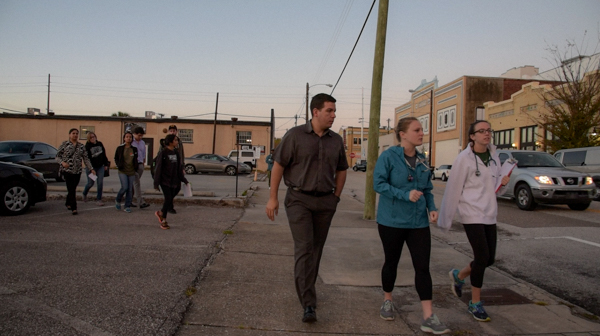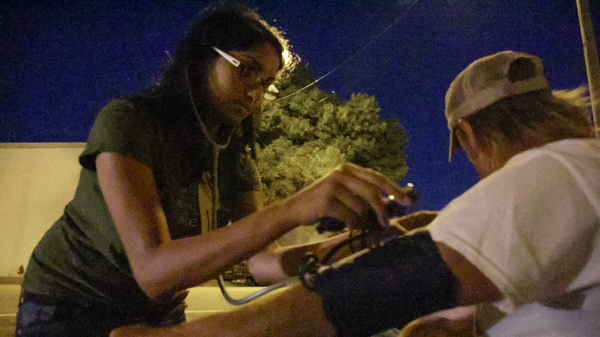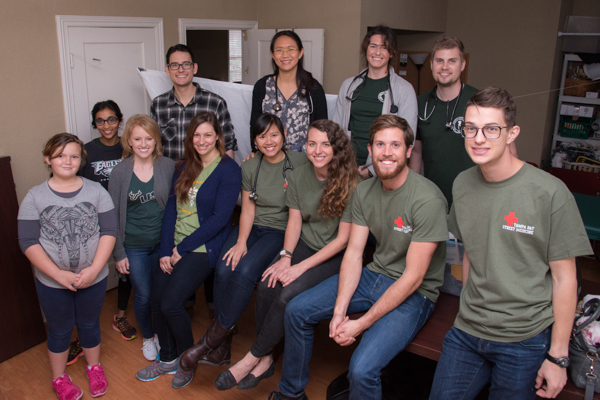The group visits the homeless where they live – on the streets. They go without white coats, carrying backpacks stocked with over-the-counter medications, first aid supplies, hygiene products and socks. They sit next to their patients on a sidewalk or curb and make eye contact. “How are you? Anything we can do to help you tonight?” the medical students ask.
The Tampa Bay Street Medicine Project (TBSM) was founded more than two years ago by five University of South Florida medical students with the support of a grant from Alpha Omega Alpha honor medical society. The core group shared a common passion: providing much needed health care and advocacy for a homeless population often neglected. Since July 2015, the project’s student volunteers have logged nearly 1,600 interactions with homeless individuals during their street runs on the outskirts of downtown Tampa and at clinics conducted at The Well drop-in center and First Presbyterian Church of Tampa.
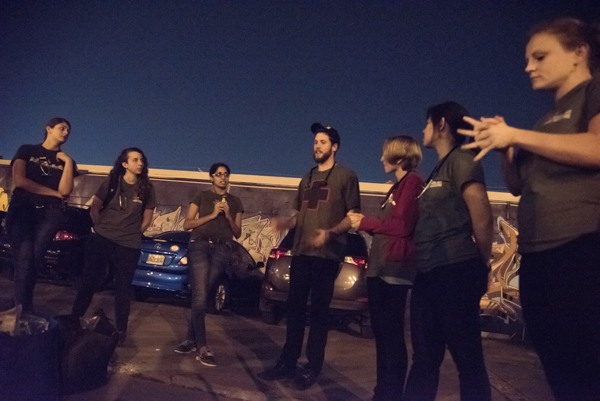
They are supervised by volunteer faculty physicians and other health professionals, who step in when more severe problems arise. But the dozen or so students – who gather in a vacant parking lot adjacent to a graffiti-covered wall every other Friday evening and disperse in small groups to offer care to the homeless – do much themselves. They take medical histories, do physical check-ups and hygiene education and address many common medical complaints, including musculoskeletal pain (common among those sitting and sleeping on sidewalks), headaches, coughs and congestion, itchy skin, wounds, and a lot of foot problems.
The USF project was modeled after the tenets set forth by the International Street Medicine Institute, which leads a global network of more than 80 groups practicing street medicine.
“Their motto is we go to the people,” said Eric Monaco, one of the founding members of Tampa Bay Street Medicine who last year served as a co-president for the student-run organization. “It levels the playing field and helps build trust when you meet with people where they are — whether that’s under the bridge at I-275 or at a bus station near the Salvation Army.”
Breaking down barriers
Monaco graduated in April 2016 from the Morsani College of Medicine and plans to continue street medicine in some capacity following completion of his family medicine residency at Ventura County Medical Center in Ventura, CA. On street runs earlier this year, Monaco did not hesitate to approach a woman lying on the sidewalk to check on her or gently lean in to touch the shoulder of a man sitting beneath a street lamp with his head buried in his knees. He often stopped to chat with those he cared for and knows by name; and, in turn, they often greeted him with a smile and occasional handshake.
The stereotypes of homelessness break down once you begin listening without judgment to stories about how people end up on the street, the students say.
Many struggle with mental illness and addiction, without family support or other safety nets to catch them when they fall, said Shawna Foley, a fourth-year medical student and president of Tampa Bay Street Medicine.
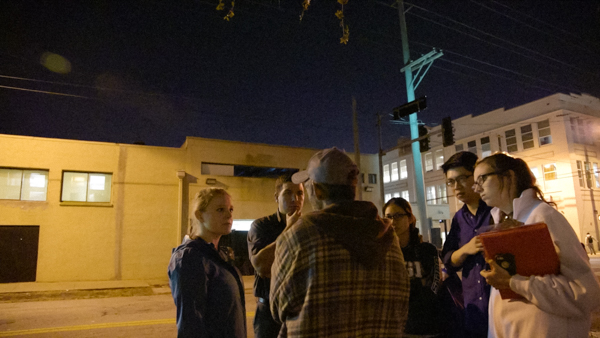
“I think there’s often an assumption that the homeless are lazy or don’t want to work, but that’s not the case for many of the people I’ve met out here,” Foley said. “We’ve provided care to a professor and other people who were in high-powered jobs and made good money. Something just happens — a death in the family, an illness, an injury from a car accident — which leads to a chain of events that brings them here.”
Perhaps even more valuable than the basic medical and preventive care provided, the students say, is their willingness to listen to those they meet. To begin to see the individuals, rather than nameless and faceless people on the streets.
“I really don’t believe people choose to live on the street, but I think many choose to make the best of it,” Monaco said. “They have really valuable perspectives, and I’ve learned a lot from the conversations we’ve shared about their experiences.”
Dr. Waldo Guerrero, an assistant professor of neurology and a street medicine faculty advisor, says every time he accompanies students on a street run it reinforces his passion for helping those who are underserved, often with the least access to care.
“I definitely think this project breaks down barriers,” Dr. Guerrero said. “I’d love more faculty to come out and be part of it. Every time I do it reminds me of why I went into medicine and just how fortunate we are, in general, as physicians.”
“We’re limited in the extent of care we can provide with the resources we have,” he added. “But just being able to take time to have a conversation with someone, to hear them out, is something we don’t necessarily do on a daily basis when we’re seeing multiple patients in a hospital or clinic.”
First Backpack, First Encounter
The contents of the backpacks carried have evolved since the first five students embarked on their initial street run with one borrowed backpack.
“The first time… we just threw together a bag with stethoscopes, blood pressure cuffs and some basic meds,” Monaco said. “We were in a completely different environment than the hospital and clinics and so maybe that backpack was a little symbol of safety to us.”
As they returned with more and bigger backpacks, the students began asking people they saw regularly what they needed. They sought donated items and stocked the packs with toenail clippers, feminine hygiene products, blanket and beanies, and more socks, which seemed to always run in short supply.
Foley recalls feeling a little anxious and awkward the first time she went out on a street run. She was unsure how to introduce herself or ease into the community of homeless. But, she says, the encounters got easier the more times she went out.
“You just have to sit down in the dirt and have real conversations with people,” Foley said. “I emphasize that with a lot of the first-and second year-students who come out on the street for the first time. Don’t be afraid to get your hands dirty; you’re not wearing white coats.”
The street medicine project became her favorite part of medical school the first year, Foley added. “I always left the street runs feeling so good about everything we were doing and so much gratitude for everything I had. And that really helped, because it was hard my first semester in medical school.”
Expanding the Reach
In 2014, TBSM partnered with The Well, a community drop-in center on Florida Avenue offering a variety of services for the homeless, so that students could provide follow-up care for their patients from the streets in a sheltered location.
Tom Logan was among the homeless patients helped by USF medical students at The Well. Before he ended up on the streets in downtown Tampa, Logan said he lived with his family in a two-story home he owned and was making $50,000 to $60,000 a year as a courier and a building inspector in St. Louis, Mo. Now he falls asleep to the “sound of sirens.”
“It’s not a joke when people say you’re one paycheck away from being homeless,” Logan said. “What the students are doing is very important. They’ve helped me watch my diet, watch my weight and kept a check on my blood pressure – things I wouldn’t be able to do on my own.”
Although The Well’s daytime drop-in center on Florida Avenue closed its doors in November (the organization is transitioning to a mobile model of outreach to the homeless), TBSM continues to operate a free indoor health clinic the third Saturday of each month at First Presbyterian Church of Tampa on Zack Street. A second monthly clinic will be added at the church beginning in February 2017.
The arrangement allows medical students supervised by licensed health care practitioners to offer more in-depth, personalized care than possible on street runs. For instance, they can provide more extensive wound care, prescribe some basic medications and monitor those with high blood pressure and chronic conditions, such as diabetes, arthritis and heart disease to help keep them out of the emergency room.
The students are also exploring the possibility of working with residents and faculty from the Department of Psychiatry and Behavioral Neurosciences to provide some mental health services.
And, this November, Skye Schmelzer donated to TBSM $25,000 of a $50,000 Lightning Foundation grant she received when she was honored as a Tampa Bay Lightning Community Hero of Tomorrow. Schmeltzer, who endured many nights of uncertainty as a homeless teenager in high school and is taking classes at USF to help her apply to medical school, intends for the funds be used to help USF’s TBSM establish a mobile outreach clinic to serve the homeless in the Tampa Bay area.
“I think it’s a huge advantage for these medical students, many of whom come from the suburbs, to be connected with people who live in a different world,” said Jon Dengler, executive director of The Well. “My hope is that they remember the relationships they’ve made with our guests from the streets, so once they are practicing doctors they not only remember the poor financially but also are better equipped to treat patients from all walks of life without prejudice.”
Meanwhile the TBSM continues to seek more student and faculty volunteers. The goal of serving more homeless, however, may require additional resources from the university or community, especially as grant funding runs out, Foley said.
For more information on the Tampa Bay Street Medicine Project, visit http://tbstreetmed.wix.com/tbsm.
Video and photos by Sandra C. Roa, USF Health Communications
